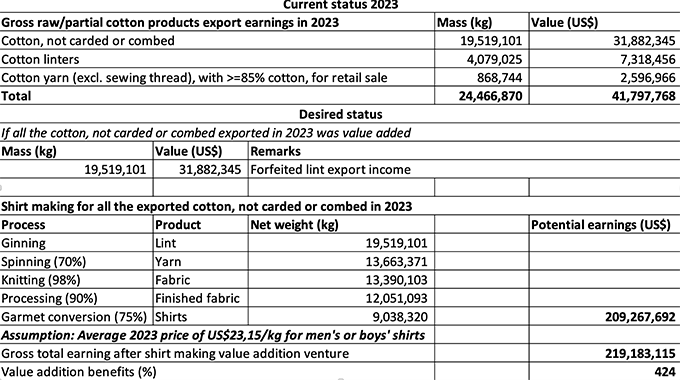US$219m revenue possible with value added cotton

Tariro Stacey Gatsi and Edgar Vhera
IF the country had exported shirts from processed cotton and not raw lint, it would have scooped US$219 million, marking a 424 percent increase from the US$42 million netted in 2023.
Statistics from the Zimbabwe National Statistics Agency (ZimStats) show that export earnings from raw cotton (cotton, not carded or combed) reached US$31 882 345 in 2023 after 19 519 101 kilogrammes of the white gold were exported at an average price of US$1, 63 per kg.
If this raw cotton was value added to men or boys’ shirts, then the country would have earned US$209 267 692.
The country also exported cotton linters and yarn and earned US$7 318 456 and US$2 596 966 respectively.
Had the country exported cotton linters, cotton yarn and shirts (instead of cotton, not carded or combed) from the total mass of 24 466 870kg exported in 2023, it would have made a lot of revenue.
The above realisation amplifies farmers’ call for increased value addition of raw cotton into finished products as a necessary means to revitalising the industry.
Various farmer associations and industry stakeholders say the move will not only benefit cotton farmers but will also have ripple effects on related industries such as textiles and garment manufacturing.
Cotton Council of Zimbabwe (CCOZ) chief executive officer, Engineer Chris Murove said value addition was the only way to go and the current mind set had to change for rural industrialisation.
“Once the cotton farmer has access to their seed and lint, then other value addition or industrial processes can happen, for instance, oil seed crushing to extract and refine cooking oil and the remaining cotton cake being used to manufacture feed for beef and dairy cattle,” he said.
Speaking during the launch of the 2021/22 cotton marketing season in Mahuwe, Minister of Lands, Agriculture, Fisheries, Water and Rural Development, Dr Anxious Masuka urged stakeholders to embrace cotton value addition, as the country journeys towards industrialising rural communities.
“We can’t have a situation where our farmers are not involved in the processing of their produce,” he said.
Dr Masuka’s call comes at a time the Government is emphasising on value addition of cash crops to create both employment and value from primary production.
“Cotton production should be value added and processed in the areas in which it is being produced so that employment is created locally,” said Dr Masuka stressing that the move would be a key component of the devolution agenda.
Meanwhile, the Government is also moving to empower women in the textile industry as part of the Ministry of Women Affairs, Community, Small and Medium Enterprises Development’s agenda to economically prop women and promote growth in their businesses.
Information, Publicity and Broadcasting Services Minister, Dr Jenfan Muswere, said the Ministry of Women Affairs, Community, Small and Medium Enterprises Development had indicated women in the textile industry in Bulawayo would access and use specialised equipment in the production of high-quality products.
Overall, local industry processes about 20 percent of its lint production. The Government ensures that the local textile industry’s lint requirements are met by ensuring that each ginner reserves 30 percent of lint production for local consumption.
“A makerspace for women in the clothing and textile industry is being established at the Bulawayo SMEs Centre. Through the makerspace, women in the textile industry in Bulawayo will access and use specialised equipment in the production of high-quality products. A total of 1 000 women will benefit from the project annually,” said Dr Muswere.








Comments